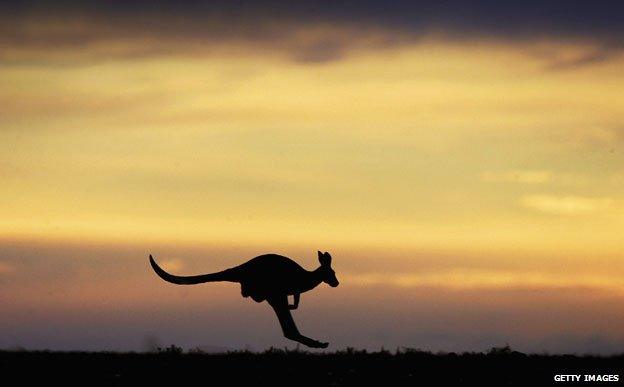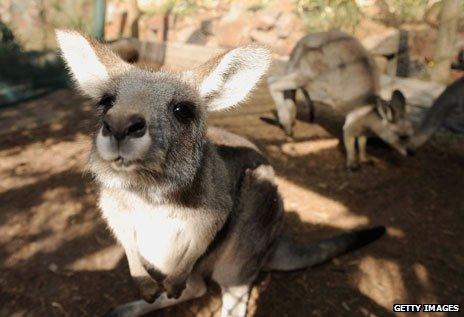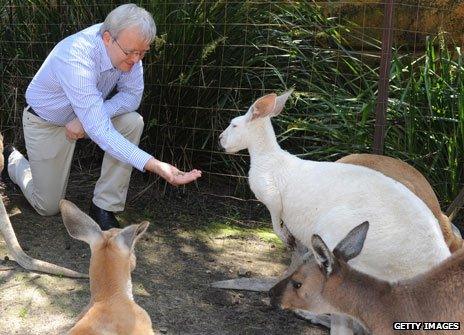Eating Skippy: Why Australia has a problem with kangaroo meat
- Published

Australians have an ingrained reluctance to eat their national emblem, but a number of chefs are now championing kangaroo meat as a delicious - and environmentally friendly alternative to beef and pork.
The glass cabinets of Dean Cooper's butcher's shop in the Central Market in Adelaide are stacked with leg roasts, steaks, meatballs, kebabs and sausages, as you might expect. But unlike any other butcher in Australia, or indeed the world, Dean Cooper only sells meat from the kangaroo. It's a healthy meat, he tells me: low in saturated fats, full of iron, free-range and organic. And if you don't overcook it, he says, it's magnificently tender. One of his regular customers, Carol Wyld, says she's been shopping here almost since the shop opened, 30 years ago. "Kangaroo meat is much better than lamb or beef," she tells me, "It's beautiful, it just melts in your mouth. And kangaroo tail soup is just divine. I'll be making lasagne tomorrow night with minced kangaroo instead of beef."
Like many foreign cooks and food writers visiting Australia, I was dying to try some of the country's unique local ingredients, and none of them more than kangaroo. On a previous visit to the country I'd been impressed by local chefs' commitment to sourcing the finest produce, and by the way their menus described the provenance of fresh seafood, heritage tomatoes and free-range pork. This time, I wanted to see how they cooked one of their most distinctive native Australian ingredients. And I knew that kangaroo meat had much to recommend it from an environmental point of view.
Kangaroos produce far less of the greenhouse gas methane than the cattle brought over by European settlers, and their jumping feet don't damage the fragile Australian topsoil like the hard hooves of cows and sheep. Although kangaroos are a protected species, there are so many of them that they are widely regarded as pests, and they are hunted by professional shooters according to a strict quota system. In an era when chefs all over the world are clamouring to use wild, seasonal and local produce, one might expect kangaroo meat to take pride of place on Australian menus.

Dean Cooper's shop
Surprisingly, however, most Australians refuse to eat it. On my first days in Adelaide, in South Australia, I scoured restaurant menus in vain for kangaroo dishes. The Greek, Korean, Chinese and Afghan restaurants I visited were testament to the multiculturalism of the Australian diet, but their menus maintained a studious silence on the subject of kangaroo. The only place I found it served was the Red Ochre Grill, a riverside restaurant that specialises in indigenous ingredients. There, some friends and I tasted rosy, sweet-cured kangaroo fillet, and a thick tranche of kangaroo steak served medium rare from the grill. But as head chef Nick Filsell admits, many of the restaurant's customers are tourists and other out-of-town visitors. "Kangaroo is a bit of a novelty meat, like crocodile and emu," he says. "Most local people wouldn't have it at home."
Most Australians I talk to in Adelaide and Sydney say they feel funny about eating kangaroo. "After all," one young woman explains, "it's our national emblem." She confesses that the only kangaroo meat she's ever had in the house was to feed to her kittens. Almost everyone I speak to mentions what they called "the Skippy factor" - a reference to the 1960s TV series, Skippy the Bush Kangaroo, which encouraged Australians to see kangaroos as far too adorable to cook for dinner. Eating kangaroo, one chef tells me, feels a bit like eating Bambi, that cute young deer in the Disney cartoon.
In the past, kangaroo meat was more widely accepted. It was always eaten by aboriginal Australians, for whom the succulent tail, roasted in a pitful of embers, is a particular delicacy. The early European settlers ate kangaroo out of necessity, and many eventually came to enjoy a red meat that didn't really taste so different from venison, hare or beef. According to historian Barbara Santich in her book Bold Palates: Australia's Gastronomic Heritage, kangaroo recipes appeared regularly in cookbooks until the 1930s. Kangaroo soup was highly prized, as was "steamer", a stew made from kangaroo enriched with salt pork. But as more Australians moved to the cities and living standards rose, kangaroo meat and other so-called "bush tucker" fell out of favour.

Like eating Bambi?
Celebrated chef Neil Perry tells me people considered kangaroo meat unsanitary because it was shot in the wild and didn't come from the sanitised environs of an abattoir. His wife Sam adds that it is hard to escape the idea of roadkill. "People think of kangaroos being hit by cars," she says, "and lying on dusty roads in the baking sun." Animal rights activists have also stirred up anxiety about killing female kangaroos that might have joeys (baby kangaroos) in their pouches.
So more than 70% of the meat is exported, mainly to Russia. Some of what remains is used as pet food (kangaroo butcher Cooper says his friends still tease him, asking: "You still got that pet meat shop?"). But the tail, and occasionally steak, are eaten enthusiastically by Australia's Chinese population, and Chinatown is one of the few places in Sydney where it can easily be bought.
A few pioneering chefs, though, are trying to revive interest among the Australian public in eating kangaroo, or at least its smaller, daintier cousin, the wallaby. One of them, Kylie Kwong, is passionately committed to using indigenous ingredients in her Chinese restaurant, Billy Kwong: warrigal greens, saltbush, sea parsley and quandongs or desert peaches all appear on her menu. "I jumped at the chance to use a native meat," she says. "This wallaby comes from the pristine environment of Flinders Island, and the quality is so high you can even serve it raw, like carpaccio. I think our customers are pleasantly surprised by how good it tastes." When she welcomes me into her kitchen, Kylie conjures up a plateful of red-braised wallaby tail with native fruits, and another of stir-fried wallaby tenderloin with black bean and chilli. The tail is meltingly delicious, like an Australian oxtail, and the tenderloin as tender as its name suggests, with a delicate gamey flavour that reminds me of pigeon breast.

Many Australians are reluctant to eat their national emblem
On my last day in Sydney, Neil Perry allowed me into the kitchens of his Chinese restaurant, Spice Temple, for some of my own culinary experiments. As a cook trained in China, I take a Chinese approach. I cut some Flinders Island wallaby into slivers and stir-fry it with Chinese yellow chives; slice some more and give it the Hunanese treatment, flash-frying it with chilli, ginger, garlic and cumin; mince the rest and use it instead of beef in the Sichuanese classic, Pock-Marked Old Woman's Tofu. I also make a kangaroo tail soup, slow-cooking the tail with wine, chicken and spices, and serving it with a chilli bean dip.
There is certainly nothing weird about the taste or texture of either wallaby or kangaroo. I'd heard that the lean meat, like chicken breast, would become leathery if overcooked but swift stir-frying keeps it tender and succulent. The spicy tofu dish is just as good as the beefy original, and anyone unknowingly eating the tail would take it for an oxtail.
With rising global population, increasing demand for meat and widespread environmental degradation, experts are warning that we will all have to challenge our gastronomic prejudices in the future. The United Nations is even promoting insects as a sustainable source of protein. Many of the world's most famous chefs are also taking a stand for local, sustainable ingredients. Rene Redzepi, the founding chef of the Copenhagen restaurant Noma, previously garlanded as the best restaurant in the world, is globally renowned for his insistence on using only Nordic ingredients. On a visit to Sydney in 2010, he lambasted Australians for ignoring the produce in their own backyard. "I think it's weird that I haven't been served kangaroo here," he told an audience at the Sydney Opera House.
In the face of pressing environmental issues, a fashion for gastronomic localism, and the efforts of local chefs like Kylie Kwong to shake up their perceptions, perhaps in the future, once again, Australians will come to enjoy kangaroo soup for their dinner.
You can follow the Magazine on Twitter, external and on Facebook, external